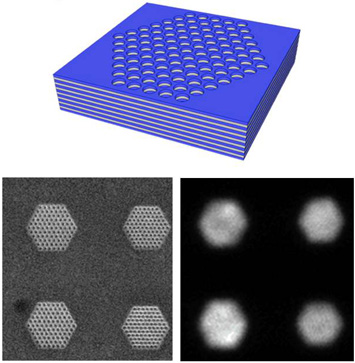Photonic Hypercrystals Shine Brightly and Colorfully
July 19, 2017
What is the scientific achievement?
The operation of photonics technologies such as lasers and detectors relies on confining light within structured materials such as photonic crystals and metamaterials. In this work, the team demonstrates a new class of artificial optical media called a photonic hypercrystal, which simultaneously outputs light with high efficiency and across a broad range of wavelengths.
Why does this achievement matter?
Simultaneous enhancement of both the light emission rate and the wavelength range gives the materials promise for fabricating ultrafast light-emitting diodes, improving solar light harvesting, and realizing deterministic single photon sources.
What are the details?
 enlarge
enlarge
(Top) Schematic of a photonic hypercrystal, - a layered material with a lateral hexagonal pattern. (Bottom left) Electron microscope image of four hypercrystals with slightly different sizes. (Bottom right) A corresponding image of light output shows the hypercrystal shines brightest when it has a specific size (lower left).
These materials have potential to enable fabrication of ultrafast light-emitting diodes, which is a foundational need realizing Li-Fi — a wireless technology that transmits high-speed data using visible light communication. These hypercrystals can also enhance absorption in solar cells, and can even facilitate development of single photon emitters for quantum information processing.
Photonic crystals and metamaterials are two of the most well-known artificial materials used to manipulate light. However, they suffer drawbacks such as limitations on bandwidth, and relatively low light emission. Photonic hypercrystals merge the best properties of photonic crystals and metamaterials to overcome the limitations of each component. In this work, the team demonstrates significant increases in both light emission rate and intensity from nanomaterials embedded inside hypercrystals.
CFN Capabilities:
Samples were characterized using the CFN Advanced Optical Spectroscopy and Microscopy facilities.
Publication Reference
Tal Galfsky, Jie Gu, Evgenii E. Narimanov, and Vinod M. Menon, Photonic hypercrystals for control of light–matter interactions, PNAS (2017) doi:10.1073/pnas.1702683114
PNAS: "Photonic hypercrystals for control of light–matter interactions"
Acknowledgement of Support
We acknowledge the support of Army Research Office (ARO) W911NF-15-1-0019 (to T.G. and V.M.M.) and ARO W911NF-14-1-0639 (to E.E.N.); National Science Foundation (NSF) Division of Materials Research (DMR) Materials Research Science and Engineering Centers Program Grant DMR-1120923 (to V.M.M. and E.E.N.); NSF DMR 1629276 (to E.E.N.); and the Gordon and Betty Moore Foundation (E.E.N.). Research was carried out in part at the Center for Functional Nanomaterials, Brookhaven National Laboratory, which is supported by the US Department of Energy, Office of Basic Energy Sciences, under Contract DE-AC02-98CH10886.
2017-12372 | INT/EXT | Newsroom









